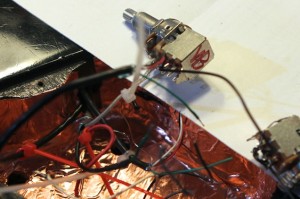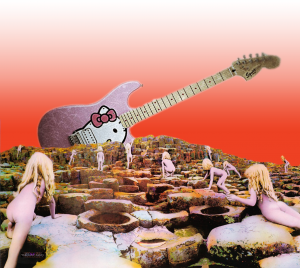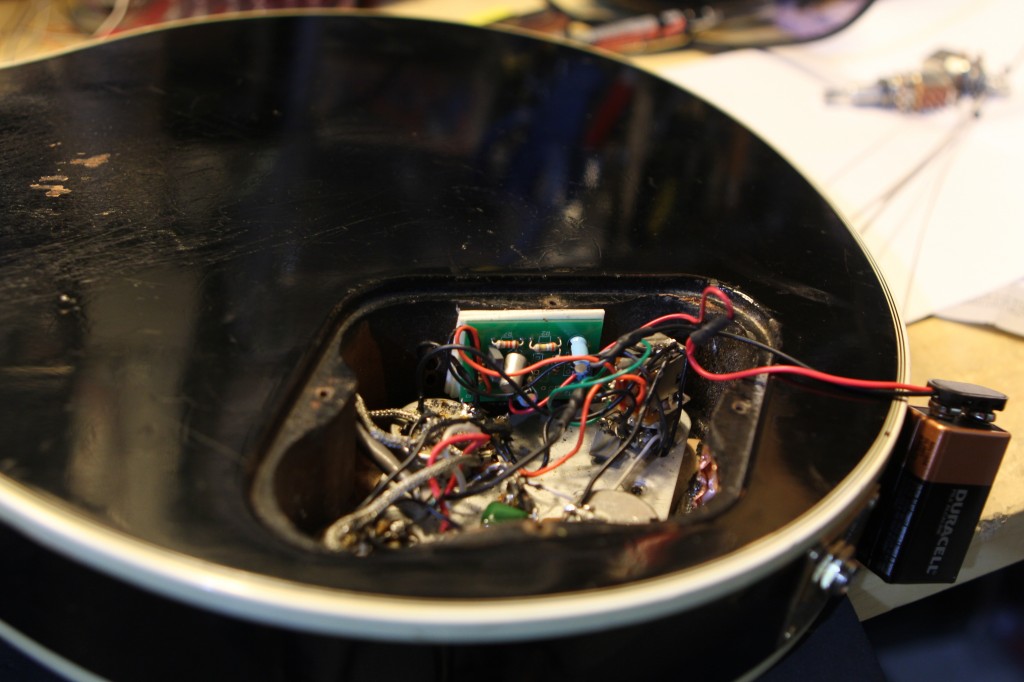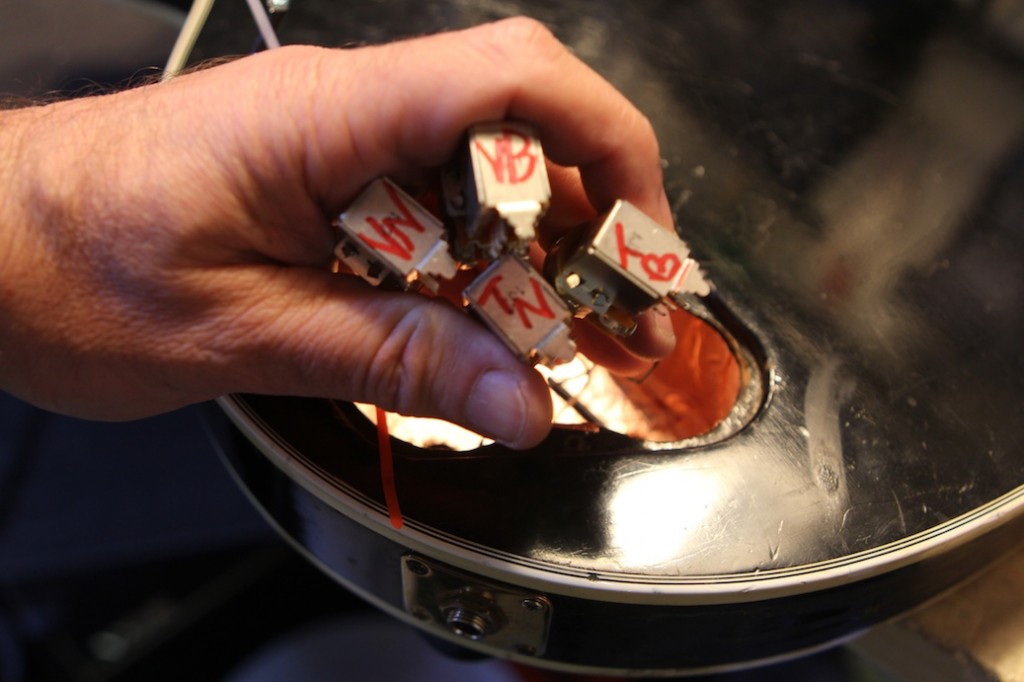As promised, here are a demo video and tech notes for the first phase of the Pagey Project, which recreates Jimmy Page’s original Les Paul wiring scheme. (The upcoming Phase Two will expand on the idea with even more crazy options.)
All I can say is, sheesh! Why did it take me decades to try out this awesome Les Paul mod?
I think it’s because I had a nasty dual-humbucker guitar many years ago with series and coil-split switches. Even though I knew the pickups were crap, it still prejudiced me against alternate humbucker wirings. “Just pick up a Fender!” I’d think.
Another factor: I lacked the sophistication to know that, while many of the tones unlocked by the Pagey wiring sound thin and/or weird on their own, they can be quite useful in context.
And make no mistake — except for the series switch, all the alternate Page sounds are smaller than stock Les Paul sounds. And that’s a good thing! They’re great for crystalline clean tones, ratty faux-P-90 distortion, and simply making the regular Les Paul sounds seem gigantic by contrast.
Have a listen. There video starts with a 90-second overview, then works through the system in detail:
Some pics and observations from the installation process:
At the recommendation of Scott Miller, one of Seymour Duncan’s wiring geniuses, I used a pair of ’59 Model pickups for the project. I worked from the schematic Scott used for his 2008 Guitar Player magazine article, which differs slightly from the one that used to be posted on the Seymour Duncan site. (I covered the parts necessary for the operation here.)
I decided to work from a clean slate and pull all the electronics from my Paul, much like gutting a Halloween pumpkin. This has been my “mad scientist” guitar, so it was a bloody mess in there!
I popped in the new pickups and routed their wires. I didn’t replace the metal shielding box used on these ’80s Les Pauls — the guitar is heavy enough without it! Instead, I applied adhesive shielding material from Stewart-MacDonald. I used four brand new long-shaft 500K push/pull pots. I labeled them with magic marker and used colored twist ties to denote the various pickup wires.
The hardest part of the job is threading wires through the tiny lugs in the push/pull portion of the pots — especially since you need to make dual connections at many of these spots. (I found it helpful to use 24-gauge stranded but pre-bonded wire from Small Bear.)
It was definitely easier to do all the wiring before fastening the pots to the guitar body. But if you care about your guitar, don’t follow my example — use a better protective material than a piece of paper.

Do as I say, not as a I do, and shield your guitar with a nice, thick cloth — not a piece of printer paper.
From that point, it was just a painstaking process of duplicating all the wire connections from the diagram. Incredibly, it all worked after the first attempt. And that never happens around here!
Despite its considerable hassle factor, I love this mod. It’s so cool and versatile that I’m going to keep it in my guitar forever rip it all out and start over. I’ll be using P-Rails pickups and Triple Shot mounting rings to unlock even more sounds than Pagey managed. Will they be worth the extra effort? We’ll find out soon. 🙂











Looking forward to seeing how you find the P Rails & Triple Shots. I have them in a 1984 Tokai Love Rock & they are amazingly versatile.
The Love Rock is a tremendous guitar the ones I have played put all but the real vintage Les Pauls to shame. As I remember they were all long tenon neck joints which is what makes a Les Paul style guitar really sing. I always wanted one but never found one while I also had the money to buy it. I was a single parent with a daughter born in 1984 so that precluded buying guitars for a long time in my life (tho’ I’ve been making up for it lately).
Matthew, what I love most about my Tokai is that it was a bargain! It cost me NZ$300 in 1995, which back then was about US$150. It was cheap because it supposedly had a small twist in the neck at about the joint, with some fret buzz in the upper register. But a refret 18 months ago when the P Rails & Triple Shots were fitted cured that. The refret, new electronics & new pots cost about NZ$1,100 (probably about US$800) but overall the cost is still way less than a new Les Paul and the guitar is just as good if not better than many Gibsons, and way more versatile.
I have high hopes, Jeff! I dig P-Rails, and wrote about them here.
I think, though, I went into this with the assumption that the P-Rails would sound better for single-coil tones, since they, unlike the PAF-style ’59s, were specifically engineered for splitting. But I’m blown away by how good the ’59s sound when split. So we shall see! 🙂
Hi Joe, I find the rails alone a little weedy on my Tokai. Maybe because my amp is a British sounding Laney Cub 15. A tremendous little amp for the price but its forte is overdriven sounds, especially humbuckers, and its clean sound is only so so. I suspect that the P 90 & rail coils on their own would sound much better through a Fender style amp. But the coils in series sound great overdriven through the Laney, and the neck pickup with the coils in parallel gives a really hot sort of fat single coil sound, which cleans up nicely when the volume is backed off. In parallel the P 90 fattens up the rail sound beautifully. I’m looking forward to trying the guitar through a big American style amp but I find that for the Laney, keeping the bridge pickup on series humbucker & the neck pickup on parallel humbucker allows me to switch between clean single coil sound, overdriven single coil sound, and overdriven Les Paul sound, using just the pickup switch & neck volume.
Thanks for the tip, Jeff. I’d been assuming the the P-Rails would sound better split than the ’59s, but dang, the ’59s sound pretty that way. It’ll be interesting to compare.
I know that you already have placed a lot of wiring & re-wiring on your plate, but I’m curious how the ’59s would sound using the triple-shots.
Sigh. That’s probably one more wiring experiment than I can manage right now. But remember, the ’59s will sound the same with Triple Shots — they’re just switches after all. The biggest differences between that arrangement and the one demoed here is that you also have the option of a) putting the coils of each individual pickup in series, and b) choosing which coil is featured in split mode. Mathematicians have a term for the number of possible sounds that provides: a buttload.
But IMHO, the #1 thing to listen for is the character and quality of the split-coil sounds. I already know P-Rails do excellent Fender and P-90-style split sounds — and the two tones are very different. My biggest surprise so far is how good the ’59 split sounds are.
I can’t imagine anyone going back to a stock Les Paul after playing this setup. Now I’m really excited for Phase Two – since the Aria demonstration, the P-Rails/Triple Shot combo has been fueling my imagination. While thinking about the Phase Two wiring and its use of only two push-pull controls, I had a truly demented idea: replacing the separate tone controls with the “Obsessive-Compulsive” Vari-Tone circuit from Mongrel Strat #3. Overkill? Probably, but it might make a killer guitar for recording and layering parts. I’m definitely going to try it someday – I figure the worst that could happen is I learn a lot about guitar wiring and end up with some really weird guitar sounds.
Yow! That would be sort of insane. I like the idea!
Just thinking aloud here, but…if you did the Triple Shot with two push/pulls scheme, but also used push-pulls for the remaining two pots…you’d still need to add two rotary additional pots, right?
Or, you could sacrifice dual tone controls for a master “Obsessive Compulsive” tone control. One knob for the pot w/ push-pull inductor, and the other knob for the rotary switch. :thumbup:
Yeah, that could be cool. 🙂
I find that I’m adjusting the volume balances obsessively in this setup, but not playing with tone much at all. I’d have no problem going with a single-tone option.
If you wanted to keep independent tone circuits for each pickup, then yes, two rotary switches would be necessary – along with some surgery to dig out room for two more controls. I was thinking of using just one Vari-Tone as a master tone control, though, so there’d just be three potentiometers (neck volume, bridge volume, master tone – like a Flying V or Explorer) and one rotary switch (capacitor select), filling the four stock control slots. Still insane, just slightly less so. 😉
Very nice demo I got a good feel for the plethora of tones available. The 59’s work quite well for this having very nice single coil tones and seem to my ear to produce some very useful sounds. I suspect that having a set of well balanced pickups make the various combinations maintain more consistent output levels. My past experiences on a SSH style guitar seemed to have more variations in output levels when switching between combinations probably due to the differences in the pickups (I never had any thing that was matched like the 59’s seem to be). I liked the series single coil and out of phase sounds the best in the demo, some of the tones were definitely outside the standard Les Paul tones (I found the same thing on my guitar years ago). I will admit tho’ that I do like the “big sloppy humbucking in series” tone personally, especially for feedback extravaganzas, add in a trem and you can have a lot of fun (I have used one for just that purpose a lot in free improv situations). Adding in the volumes for each pickup really adds to the variations as well (I would need a cheat sheet to remember all the control settings for live use tho’). In my experiments years ago I had only a volume and tone available and I can now see this was a big limitation. Overall I think you have a really useful setup going here and I could see it as a real boon to stage or studio work.
I am looking forward to the P-Rails and Triple Shot Mounting Rings demo. I am a big P90 fan and have been planning on getting a set to experiment with. I didn’t hear anything in the above demo that really sounded P90ish to me like they did to you. P90s are a very different pickup because of the size of the coil it has a much larger magnetic aperture (it sees more of the length of the string) this is what IMHO gives it the characteristic P90 sound. Humbuckers to a certain extent are also in this camp but due the fact that it is 2 coils adding together it still lacks that beautiful midrange partly because the 2 coils interact with each other in a complex manner. This causes both additive and subtractive effects on the tone and gives that sort of wooly sound you describe.
Yeah, I suspect the similar output of the neck and bridge pickups has a great deal to do with how well the alternate sounds work. I’ve never tried this with a vintage output neck pickup and a hot bridge pickup, and probably won’t — two times through this wiring is enough! 😉
Yeah, the P-90 comment was just sort of general — I guess I was referring to the fact that I was getting more explosive pick attack and less mush than with conventionally wired humbuckers. And like I said elsewhere in comments, I was quite blown away by how good the ’59s sounded in split mode. Maybe my enthusiasm ran away with me. Don’t worry — it won’t happen again! 😉
That is just too much fun ! Think part of my disliking the out of phase stuff is not playing with my knobs enough ? That just sounds wrong and no one can accuse me of that anyway ! Also still have no idea why that early era nashville custom was not to your liking in original condition ? The metal cover is just an annoying reminder of when and where my 81 is from . The idea about the OCD varitone makes my brain hurt more than normal!
That particular guitar is just sort of thick and heavy lacking in “zing.” And unlike most of my instruments, I got it not because I loved it, but because I needed a Les Paul in a hurry for a big Apple project, and it was the only one I could find for under a grand. (And even then, it desperately needed a re-fret and new pickups.) But the more I screw with it, the more I like it. 🙂
Have just done a complete overhaul on mine but still tweaking the bridge pup seems overly bright to me? Could be choice of magnets not really sure yet but I am running the tone starting at 5 now.Possibly due to the already increased treble response of ebony fretboard and the oh so wonderful stainless steel frets(low wide and not flattened!)
I like bright Pauls! The twangier, the better! 🙂
Not even going to joke about how much I have spent getting it into perfect shape but I did buy it off a rack used for 400 bucks in 1981. Maybe I need to introduce you to Jim his specialty is making pups and wiring pauls to be bright.(he has a trainwreck)
So I listened to houseoff the holy and IV tonightswitch this wiring in mind. The tone that stood out to me mostIds the rhythm fill in rock n roll. Is this an example of one of the options? Other songs to look out for? I know Brian May does something similar, is his killer queen tone an example too?
Please excuse my phone typing, editing isn’t going well 🙂
Any update on the P-Rail with JP mod yet Joe? I’m very curious to know how it went. Thanks
Hello Joe!
I’m a big fan of your videos and your incredible guitar tone.
I recently bought a 335 I want it to be more versatile. Is it possible to do a Jimmy Page Wiring with a PTB tone control?